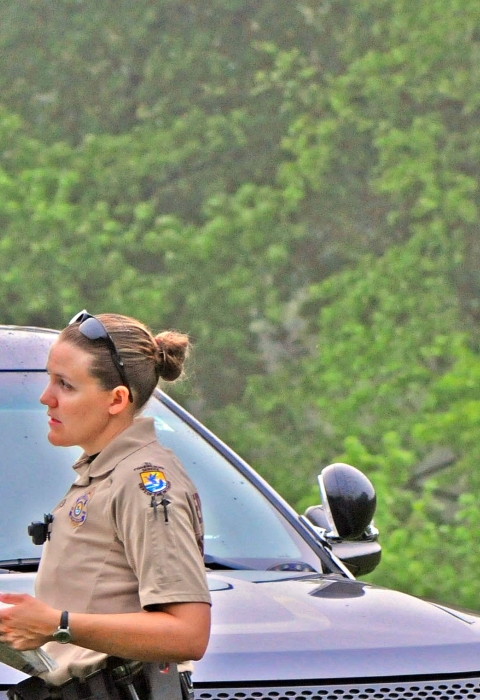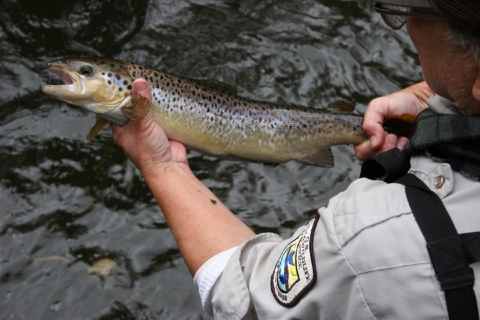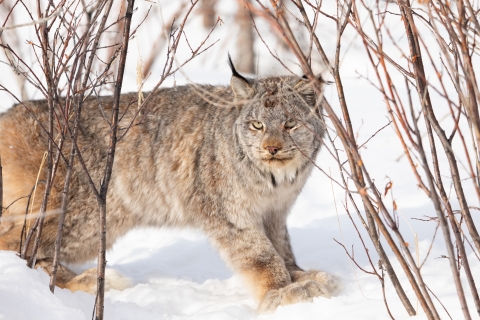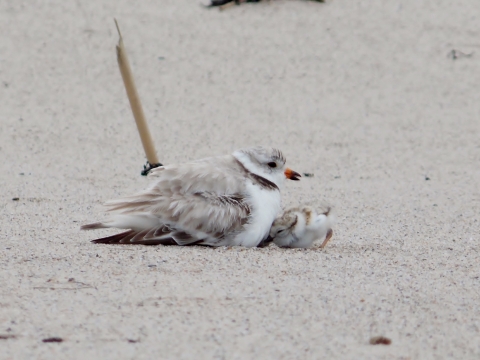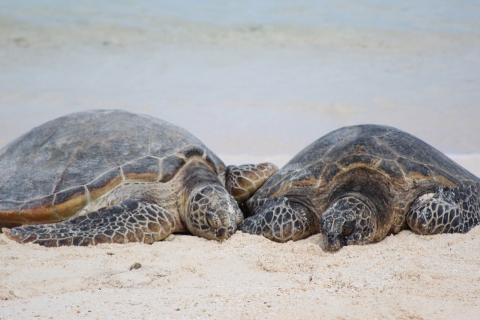Covert operations, nighttime surveillance, crime-scene investigations. That's probably not what comes to mind when you imagine people working to conserve endangered species.
But some U.S. Fish and Wildlife Service employees help threatened and endangered species by protecting them from intentional harm. At ports and national wildlife refuges, and under cover around the U.S., conservation law enforcement officials work to stop the exploitation of species that can’t defend themselves.
The federal Endangered Species Act (ESA) prohibits “take” “take”
The term “take” means to harass, harm, pursue, hunt, shoot, wound, kill, trap, capture, or collect, or to attempt to engage in any such conduct.
Learn more about “take” of listed species, which includes harassing, harming, pursuing, hunting, shooting, wounding, killing, trapping, capturing, collecting or attempting to do any of those things.
Take can happen by accident, but sometimes people target species for personal gain. Staff from the Service’s Office of Law Enforcement and National Wildlife Refuge System Division of Law Enforcement work together and with partners to intercept and investigate these crimes against wildlife, often putting their own lives at risk.
They also help protect species that are listed as endangered in other parts of the world. The ESA requires that the Service list species as endangered or threatened regardless of where they live. While each country determines whether hunting an endangered or threatened species within their borders is lawful, the ESA regulates the import of species listed in other countries to the U.S.
Conservation law enforcement officials play a vital role in protecting vulnerable species at home and around the world. The following are just some of the cases our officers have worked on with partners.
Salmon surveillance
In response to plummeting numbers of Atlantic salmon, the Service listed the Gulf of Maine population as endangered under the ESA in 2001. Although overfishing was one of the drivers of the species’ decline, some people continued to net salmon after the species was listed.
In 2009, the Service teamed up with the Maine Warden Service to conduct a joint covert operation into the unlawful take and sale of these protected fish.
Acting under the Service’s direction, the Maine Warden Service infiltrated the social circle of a person collecting and selling endangered Atlantic salmon from the Piscataquis River. The undercover operative was able to document that the suspect knew Atlantic salmon were federally protected, and a team of Maine wardens and Service special agents conducted nighttime surveillance, observing the suspect snagging Atlantic salmon out of the river as they swam upstream to spawn.
The next day, the team executed a search warrant for the suspect’s residence and vehicle and found evidence of the illegal activity: fish remains. They compared DNA from the remains with DNA from a biological study, confirming that several of the fish had been netted previously by a fisheries biologist.
The suspect was charged by the U.S. Department of Justice and sentenced to six months in federal prison, along with two years’ federal probation for violating the Endangered Species Act and the federal Lacey Act.
Missing lynx
Canada lynx in the lower 48 states were designated as a distinct population segment and listed as threatened under the ESA in 2001. While the biggest threat to the species is changing land use that affects habitat, Canada lynx are sometimes targeted for pelts or trophies.
The Service’s Office of Law Enforcement has worked closely with partners on several joint investigations into the unlawful take and possession of Canada lynx in northern New England, home to a resident breeding population.
In early 2006, U.S. Customs and Border Patrol in Hamlin, Maine, intercepted someone smuggling wildlife pelts, including one from a Canada lynx, into the U.S. from Canada. The Maine Warden Service and one of our special agents interviewed the person, who told them the pelt was supplied by a Maine resident and illegally exported to Canada to be tanned. The special agent located and interviewed the alleged supplier, who confessed to the unlawful take and sale of the lynx.
The U.S. Department of Justice filed formal charges, and the person who killed the lynx was sentenced to 21 days in prison. The person who was caught smuggling at the border served seven days in prison.
Later that year, special agents in Maine and Vermont teamed up with the Vermont Warden Service and Maine Warden Service to investigate the unlawful take of a Canada lynx shot in Maine and taken to a taxidermist in Vermont. Following numerous interviews, they identified a suspect, who was charged by the U.S. Department of Justice and sentenced to seven days in prison.
In 2008, a licensed Maine trapper unlawfully trapped, killed and hid a Canada lynx in Stacyville, Maine. The Maine Warden Service and one of our special agents teamed up to conduct a crime scene investigation and execute federal search warrants on the suspect, a vehicle and a home. In an effort to thwart law enforcement, the suspect burned his boots, destroying evidence that he had been on the scene.
Nevertheless, there was enough evidence for the U.S. Department of Justice to charge and sentence the trapper to seven days in prison.
On cue
In 2016, an anonymous tip led to the investigation of two men traveling to the U.S. to attend a billiards expo in Pennsylvania, where they intended to purchase pool cues made of elephant ivory. That year, a near-total ban on the commercial trade of African elephant ivory had gone into effect in the U.S. New York state, where the men arrived in the U.S. from abroad, had enacted its own ban in 2014. Although the African elephant was listed as threatened under the ESA in 1978, poaching for ivory continues to take a toll on species.
One of our wildlife inspectors at the Port of Newark built a profile of the men by monitoring social media and online forums. Then, working with U.S. Customs and Border Protection Passenger Analysis Unit, the inspector determined when and where they were scheduled to depart the U.S.
On cue, the men checked their bags on a flight departing from Los Angeles International Airport. Inside were pool cues made up of 44 sections of African elephant ivory, valued at approximately $85,000. As they boarded the plane, the men were stopped by our special agents, who interviewed and subsequently arrested them for smuggling wildlife parts.
The men received sentences of time served — they had been detained for six months during the legal proceedings — and were placed on supervised release for two years. After being processed through U.S. Customs and Border Patrol’s visa-removal program, they departed the U.S.
But the investigation didn’t end there. Through interviews and executed search warrants, our special agents learned that a pool-cue maker based in Los Angeles was the source of the ivory cues and conspired with the men to export them.
The pool-cue maker was arrested and sentenced to two years of probation, four months of home confinement, and a criminal fine of $10,000.
Plover patrol
While patrolling in coastal Rhode Island in 2016, a federal wildlife officer with the Service received a tip that two people had removed piping plover eggs from a closed area on Trustom Pond National Wildlife Refuge. A sandy-gray shorebird that depends on sandy beaches to nest, forage and rest when migrating, the piping plover was protected under the Endangered Species Act in 1986.
According to the informant, the suspects ignored posted “beach closed” signs, ducking under a rope used to mark off a piping plover nesting area.
Once inside, they found an active plover nest and pushed aside protective wire and netting to remove several eggs. As they showed off their find near the parking lot, the informant overheard the pair telling others they were planning to "incubate" the eggs.
The federal wildlife officer responded to the area and interviewed witnesses. After conducting a thorough investigation, the officer identified the two suspects, who ultimately confessed to their actions.
Both were successfully prosecuted in federal court.
Wild turtle chase
In 2022, an off-duty federal wildlife officer assigned to Chincoteague National Wildlife Refuge in Virginia received a call from a counterpart with the Virginia Marine Police about an incident in progress involving a green sea turtle at Kiptopeke State Park.
Reaching up to 440 pounds, green sea turtles are the largest hard-shelled sea turtles and have long been exploited for their fat, meat and eggs. The species has been listed under the ESA since 1978.
The Marine Police officer was unable to respond — could the federal wildlife officer investigate?
The federal wildlife officer suited up and met a Virginia State Parks Law Enforcement Ranger on scene.
Together they located a witness to the incident and learned that four people had captured a green sea turtle and asked the witness if they were allowed to keep it. The witness told them the species was protected and should be left alone.
But the people said they were going to keep the turtle anyway to eat.
The officers tracked down the turtle, now in the possession of someone who said it had been gifted by the people who found it.
Working together, the conservation law enforcement partners found the suspects and made the case for charging them with destroying evidence, impeding inspection or obstructing an officer, and violating the ESA.
A role for the public
Our federal wildlife officers, wildlife inspectors and special agents are passionate about their work and good at what they do. But they can’t do it alone. The Service relies on many partners, including the public, to protect vulnerable species from exploitation.
Anyone can play a role in stopping wildlife crime. Learn how you can speak up for wildlife.
